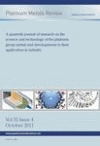-
oa Yield Point Effects in Palladium
- Source: Platinum Metals Review, Volume 11, Issue 3, Jul 1967, p. 94 - 99
-
- 01 Jan 1967
Abstract
A pronounced yield point effect is sometimes encountered when heavily worked palladium is aged between 500° and 800°C. Such strain-ageing phenomena are usually associated with body centred cubic metals such as iron, and it is surprising to find that palladium, a face centred cubic metal, can exhibit analogous behaviour. In this article it is shown that the effect is caused by the presence of silicon, in concentrations as low as a few parts per million, which can be taken up even from a nominally pure alumina crucible in melting under reducing conditions. The precise mechanism involved is not understood, although the effect, when it occurs, complicates fabrication procedures such as wire drawing, contact manufacture and the production of high quality sheet. Working difficulties of this sort can, however, be avoided by adding small quantities of sodium or calcium to the palladium in the course of melting.


